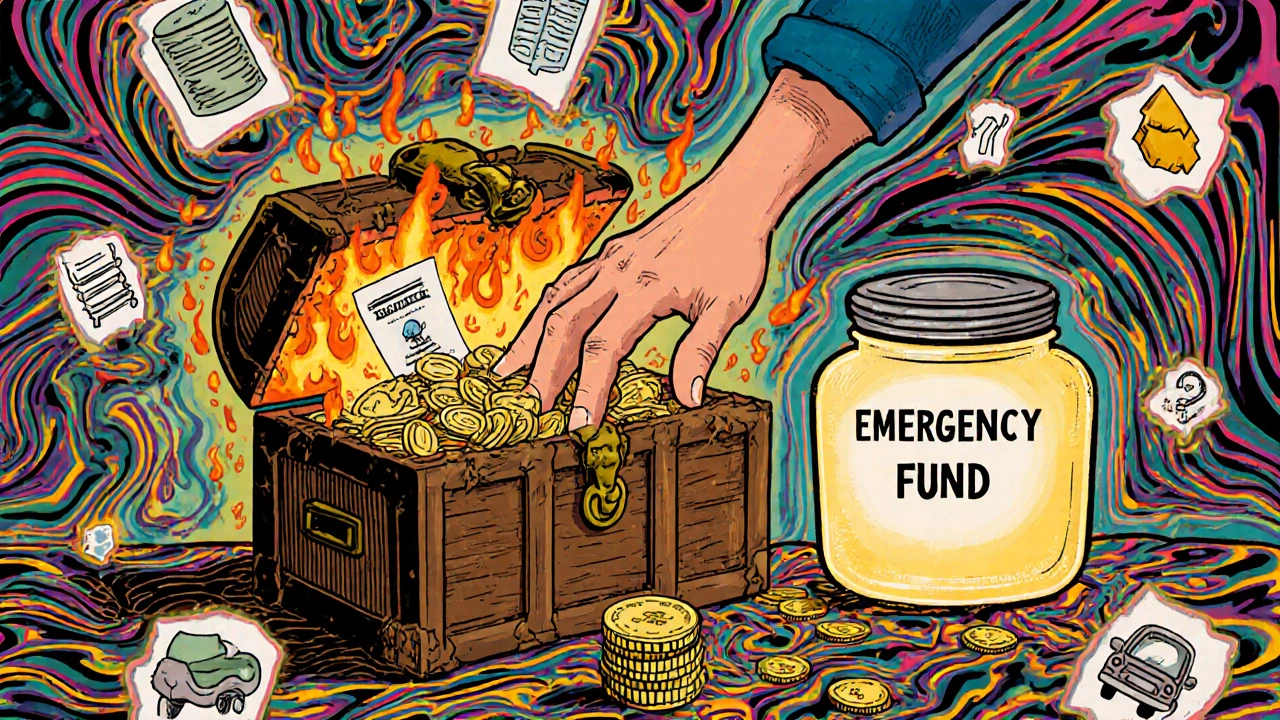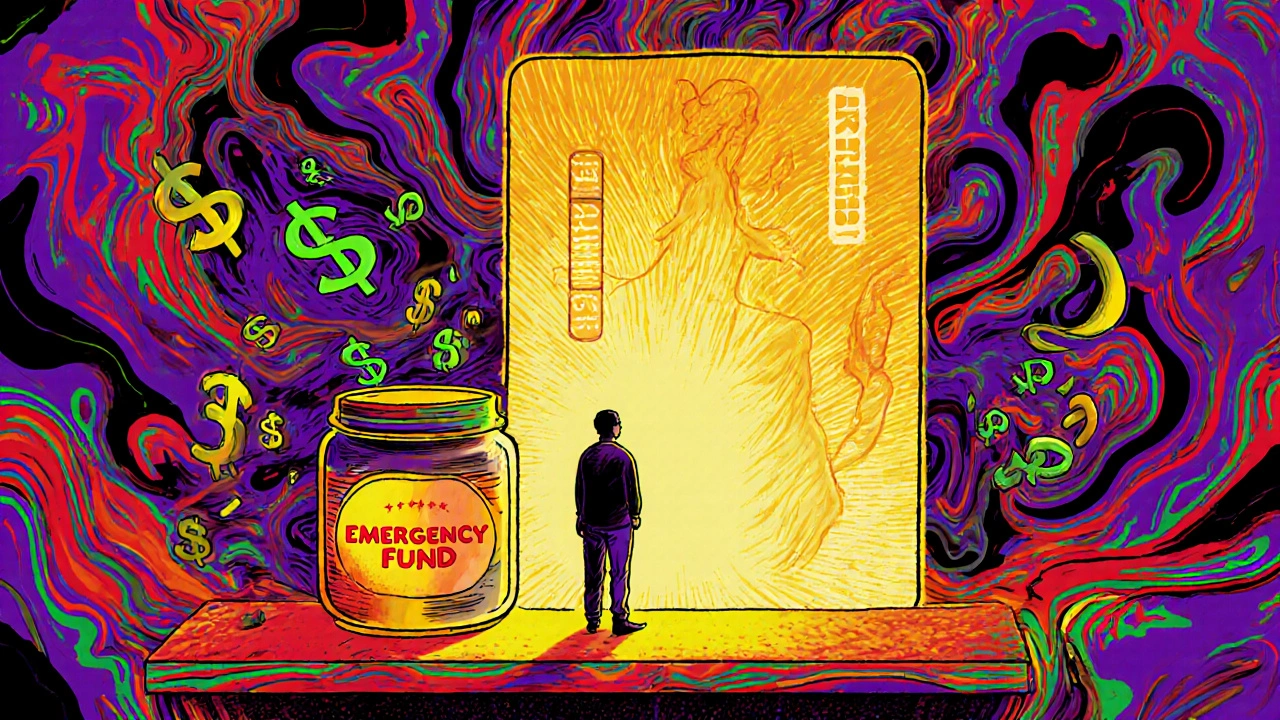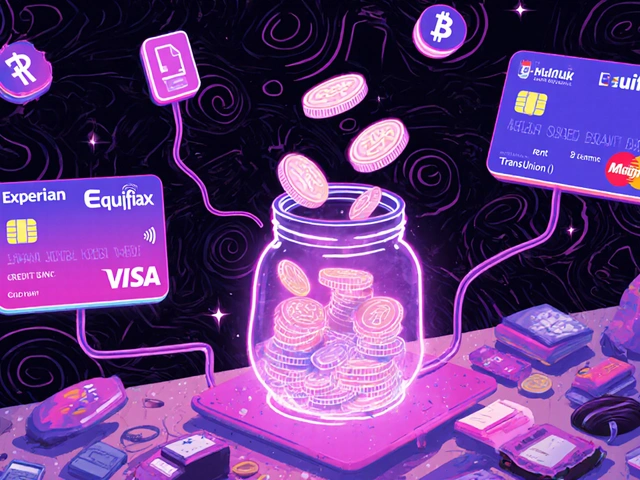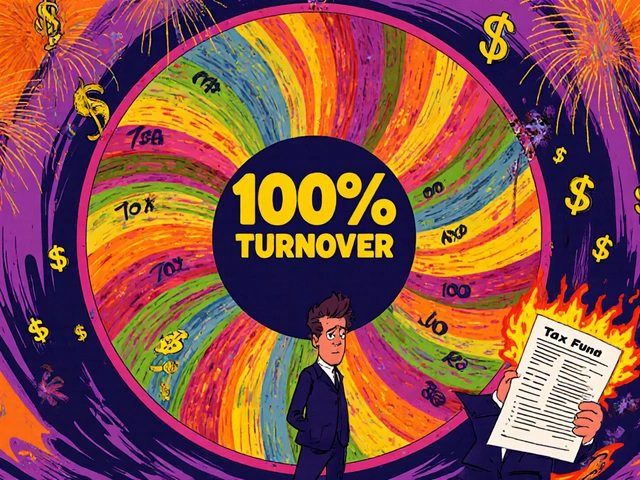Emergency Fund Calculator
Calculate Your Needs
Savings Tracker
Pro Tip: Even $25/week adds up to $1,300 in a year. That's enough for a major emergency without debt!
Your Emergency Fund Summary
The Real Cost of Credit Cards
If you used a credit card with 24.99% APR to cover a $2,000 emergency:
Saving just $25/week avoids thousands in interest
Myth #1: You Don’t Need an Emergency Fund If You Have Credit Cards
It’s tempting to think your credit card is your emergency backup. You’ve got a $5,000 limit - why not just use it when something breaks? But here’s the truth: credit cards aren’t savings. They’re debt with interest that piles up fast.
Let’s say your car transmission dies and you charge $5,000 to a card with a 24.99% APR. If you only make minimum payments, you’ll pay over $1,300 in interest over two years. That’s not an emergency - that’s a financial trap. And if you’re already carrying a balance? You’re adding fuel to the fire. Emergency funds exist to keep you from borrowing at high rates. Credit cards don’t protect you - they make things worse.
Real emergency savings? You keep it in a separate, FDIC-insured account. No temptation. No interest. Just cash you can pull out without guilt or penalty. A $5,000 emergency fund doesn’t earn much - maybe $100 a year - but it saves you thousands in avoided interest.
Myth #2: Your Retirement Account Is a Good Emergency Fund
Some people think, “I’ve got $30,000 in my 401(k). I can just take some out if I need to.” Sounds logical - until you see the fine print.
Withdrawing from a retirement account before age 59½ triggers a 10% early withdrawal penalty, plus you owe income taxes on the amount. If you’re in the 22% federal tax bracket and your state adds 5%, you’re paying 37% in taxes and penalties just to get your hands on $10,000. That means you have to pull out $15,789 to end up with $10,000 after taxes.
And that’s not even the worst part. You lose the compound growth. That $10,000 you pulled out could’ve grown to $30,000 or more over 20 years at a 7% average return. You’re trading long-term security for short-term relief - and the math never works out.
Even if you’re over 59½, tapping retirement funds for emergencies still messes with your long-term plan. You’re not just spending money - you’re stealing from your future self. That’s why financial advisors say: keep retirement and emergency savings completely separate.
Myth #3: You Only Need an Emergency Fund If You’re Single or Have a Risky Job
People with stable jobs, dual incomes, or corporate benefits often think they’re immune to emergencies. “My spouse makes enough,” or “I have good health insurance - I’m covered.” But emergencies aren’t just about job loss.
What if your kid needs an unexpected surgery? Your water heater bursts and floods your basement? Your aging parent needs urgent care and you’re the only one who can help? These aren’t “rare” events - they happen to half of all households every five years.
Even if you have two incomes, one person losing their job can still strain your budget. Inflation, medical bills, and home repairs don’t care how many paychecks you get. The Federal Reserve found that 36% of Americans couldn’t cover a $400 emergency in 2023 - and that number hasn’t budged since 2019, even among dual-income households.
Stability doesn’t mean invincibility. Emergency funds aren’t just for the precarious - they’re for everyone who wants to avoid debt during life’s inevitable surprises.

Myth #4: You Can Wait Until You Have More Money to Start Saving
“I’ll start my emergency fund when I get a raise.” “I’ll save once my rent goes down.” “I’ll begin after I pay off this credit card.” Sound familiar? This is the biggest delay tactic in personal finance.
Here’s the reality: you don’t need $10,000 to start. You don’t even need $1,000. You need $500. That’s it.
Start small. Automate $25 a week into a separate savings account. In six months, you’ve got $650. That’s enough to cover a broken appliance, a last-minute vet bill, or a flat tire without touching your credit card. Then you keep going. Build to $1,000. Then three months of expenses. The goal isn’t perfection - it’s momentum.
People who wait for the “right time” never start. The right time is now - even if you’re living paycheck to paycheck. One Reddit user in Missoula started with $10 a week while working two part-time jobs. In 10 months, she had $520. When her car needed $400 in repairs, she paid for it without stress. That’s the power of starting small.
Myth #5: Emergency Funds Don’t Grow - So Why Bother?
Yes, your emergency fund won’t make you rich. A high-yield savings account might earn 4.5% right now - but that’s still far less than the 7-10% you might get from stocks. So why not just invest it all?
Because emergency funds aren’t for growth. They’re for safety.
Imagine you’re forced to sell stocks during a market crash to cover a medical bill. You lose 30% of your portfolio. Then it takes five years to get back to even. That’s not smart investing - that’s financial self-sabotage.
Emergency funds are the anchor. They keep you steady so your investments can do their job. You don’t need your emergency money to grow. You need it to be there - instantly, reliably, without drama.
And here’s the hidden benefit: having cash on hand reduces stress. A 2022 AllSouth survey found that people with emergency savings reported 40% less anxiety about unexpected expenses. That’s not a number - that’s peace of mind. And peace of mind? That’s worth more than a few extra percentage points in returns.
Myth #6: Once You Build It, You’re Done
Too many people think once they hit their $5,000 or $10,000 goal, they can forget about it. But emergency funds aren’t set-and-forget. They’re living accounts.
If you use $3,000 for a broken furnace, you need to rebuild it. Fast. Otherwise, you’re back to square one - vulnerable and relying on credit.
Most people who dip into their emergency fund don’t replace it. The AllSouth survey found 61% of users used their fund for vacations, new phones, or dining out - not true emergencies. And it took them an average of 8.2 months to refill it. That’s almost a year of being unprotected.
Set a rule: every time you use your emergency fund, treat it like a debt you owe yourself. Pay it back before you save for anything else. Automate $50 or $100 a month into it until it’s full again. Treat it like your most important financial obligation - because it is.
Myth #7: You’re Too Young or Too Old to Need One
Some 22-year-olds think they’re invincible. “I’ve got no bills, no kids, no problems.” Others in their 60s think, “I’m retired - I’ve got Social Security.” Neither is true.
At 22, you might not have a mortgage, but you might have a sudden dental bill, a stolen laptop, or a broken phone that keeps you from your gig job. That’s an emergency. And without savings, you’re one missed paycheck away from debt.
At 65, you might be retired, but you’re not immune to medical emergencies, home repairs, or needing to help a grandchild. Medicare doesn’t cover everything. And if you’re living on a fixed income, a $2,000 unexpected cost could mean skipping groceries or medicine.
Emergency funds aren’t about age - they’re about risk. And risk doesn’t care how old you are.
How to Build a Real Emergency Fund - No Fluff
Forget vague advice. Here’s exactly how to do it:
- Open a separate high-yield savings account at an FDIC-insured bank or credit union. Don’t use your checking account. You need distance from temptation.
- Start with $500. Set up an automatic transfer of $25-$50 per week. That’s less than your daily coffee.
- Once you hit $500, aim for $1,000. Then three months of essential expenses: rent, utilities, groceries, insurance, minimum debt payments.
- Use apps like Acorns or your bank’s auto-save feature if you struggle with discipline. But watch fees - if it costs $3/month, you’re eating into your savings.
- Never touch it for non-emergencies. If you do, rebuild it immediately.
- Review it every six months. If your rent or car payment went up, adjust your goal.
That’s it. No complicated formulas. No investing. Just cash. Simple. Reliable. Powerful.
What If You Can’t Save Right Now?
Maybe you’re making $18/hour and paying $1,200 in rent. Maybe your paycheck barely covers groceries and gas. You think saving is impossible.
Here’s what works: look for $10-$20 a week you can cut. Cancel one subscription. Cook one extra meal at home. Skip the drive-thru twice a week. Bundle your phone plan. Use public transit instead of Uber once a week.
That’s $80 a month. That’s $960 a year. That’s your first $1,000.
And if you’re on a gig job? Save 5-10% of every payment. Even if it’s $5 one week and $30 the next, it adds up. Pew Research found gig workers who saved percentages - not fixed amounts - were 3x more likely to build a fund than those who tried to save $100/month.
It’s not about how much you make. It’s about how you move the money.






Comments
Oh wow, another ‘save $500’ sermon. Like, congrats, you’ve read a Medium post from 2018. If you’re making $18/hour and rent is $1,200, $500 won’t save you-it’ll just delay the inevitable credit card plunge. Real talk? The system’s rigged. Emergency funds are a Band-Aid on a hemorrhage. You want real financial security? Fight for universal healthcare, rent control, and a living wage. Until then, ‘just save’ is bourgeois nonsense dressed up as empowerment.
Thank you for this. 😊 I live in India, where emergency funds are rare because incomes are unstable and banks don’t always feel safe. But I started with ₹1,000 (~$12) last year-just from skipping tea outside. Now I have ₹15,000. It’s not much, but when my mom needed medicine last month, I didn’t panic. Small steps, right? 💪
Julia here-just wanted to gently push back on the ‘you’re too young/old’ myth. I’m 68, retired, and my emergency fund saved me when my hip replacement wasn’t fully covered. Medicare paid $12,000 of the $18,000 bill. The other $6,000? From my fund. No debt. No stress. I didn’t touch my IRA. I didn’t sell stocks. I just used the cash I’d been quietly squirreling away since 2015. It’s not glamorous. But it’s peace. And peace is priceless. Also-yes, the $500 start is real. I started with $20 a paycheck. Took 10 months. Worth every penny.
Let’s deconstruct the epistemology of liquidity here. The emergency fund isn’t a savings vehicle-it’s a negative-option hedge against systemic volatility. In neoclassical terms, it’s your personal counter-cyclical fiscal buffer, decoupled from the risk architecture of credit markets and retirement portfolios. The 4.5% yield? Irrelevant. What matters is optionality. When the car dies, you don’t liquidate your VTI position during a bear market-you access your non-correlated, zero-convexity cash reserve. That’s not frugality. That’s financial alpha. And the behavioral economics? Pure loss aversion mitigation. You’re not saving for a flat tire-you’re preserving your long-term utility function. Also, stop calling it a ‘fund.’ It’s a liquidity anchor. 🧠